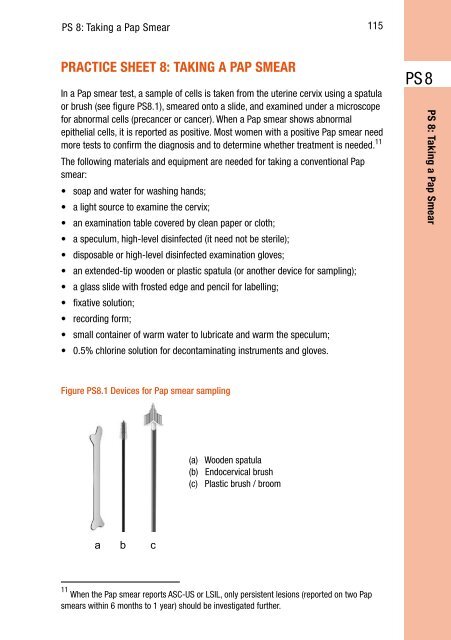CHAPTER 4: SCREENING FOR CERVICAL CANCER
CHAPTER 4: SCREENING FOR CERVICAL CANCER
CHAPTER 4: SCREENING FOR CERVICAL CANCER
You also want an ePaper? Increase the reach of your titles
YUMPU automatically turns print PDFs into web optimized ePapers that Google loves.
PS 8: Taking a Pap Smear115PRACTICE SHEET 8: TAKING A PAP SMEARIn a Pap smear test, a sample of cells is taken from the uterine cervix using a spatulaor brush (see figure PS8.1), smeared onto a slide, and examined under a microscopefor abnormal cells (precancer or cancer). When a Pap smear shows abnormalepithelial cells, it is reported as positive. Most women with a positive Pap smear needmore tests to confirm the diagnosis and to determine whether treatment is needed. 11The following materials and equipment are needed for taking a conventional Papsmear:• soap and water for washing hands;• a light source to examine the cervix;• an examination table covered by clean paper or cloth;• a speculum, high-level disinfected (it need not be sterile);• disposable or high-level disinfected examination gloves;• an extended-tip wooden or plastic spatula (or another device for sampling);• a glass slide with frosted edge and pencil for labelling;• fixative solution;• recording form;• small container of warm water to lubricate and warm the speculum;• 0.5% chlorine solution for decontaminating instruments and gloves.PS 8PS 8: Taking a Pap SmearFigure PS8.1 Devices for Pap smear sampling(a) Wooden spatula(b) Endocervical brush(c) Plastic brush / broom11 When the Pap smear reports ASC-US or LSIL, only persistent lesions (reported on two Papsmears within 6 months to 1 year) should be investigated further.
















